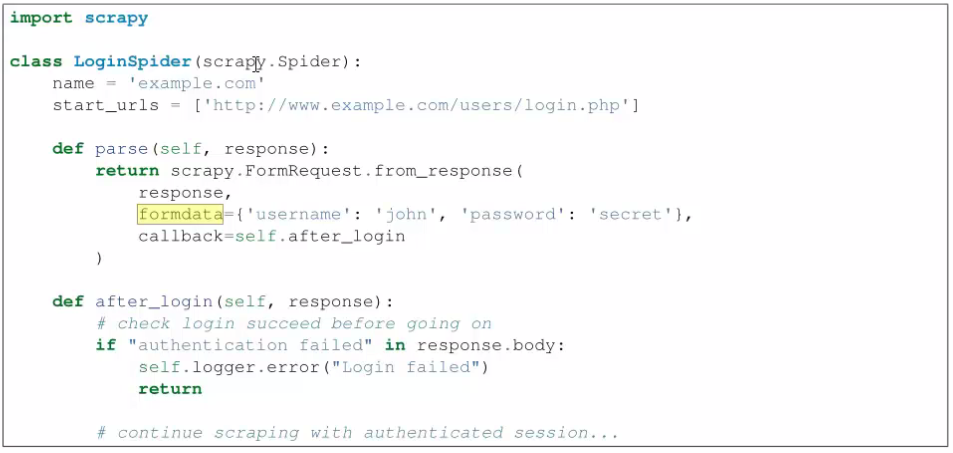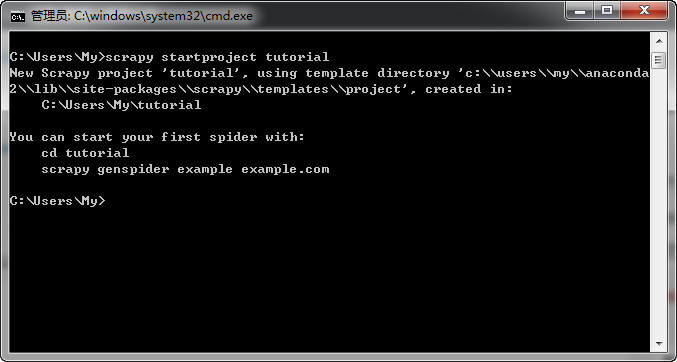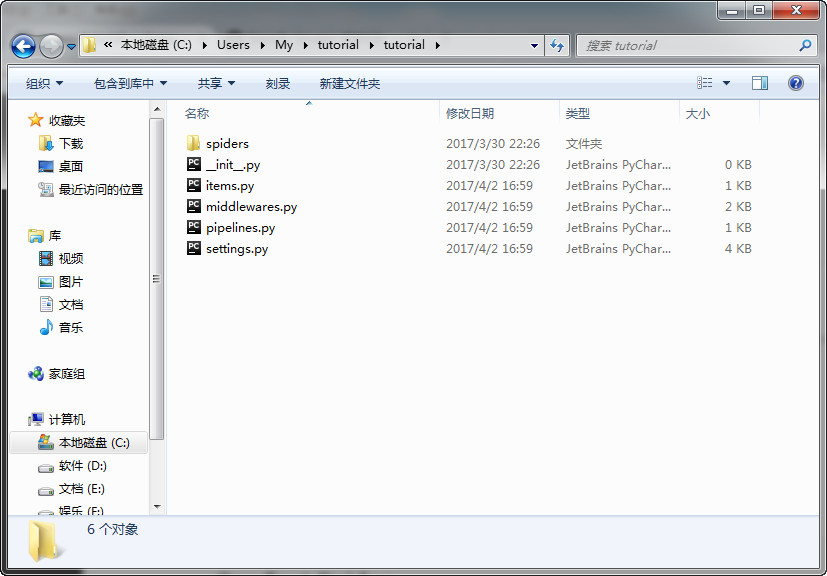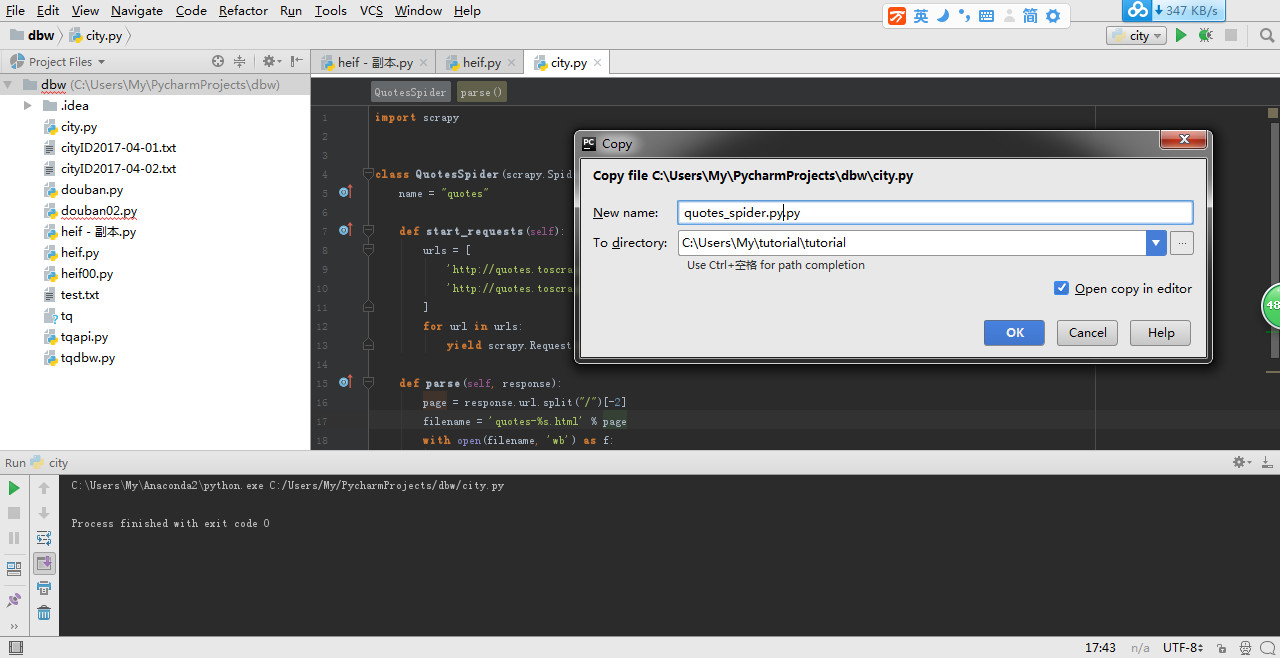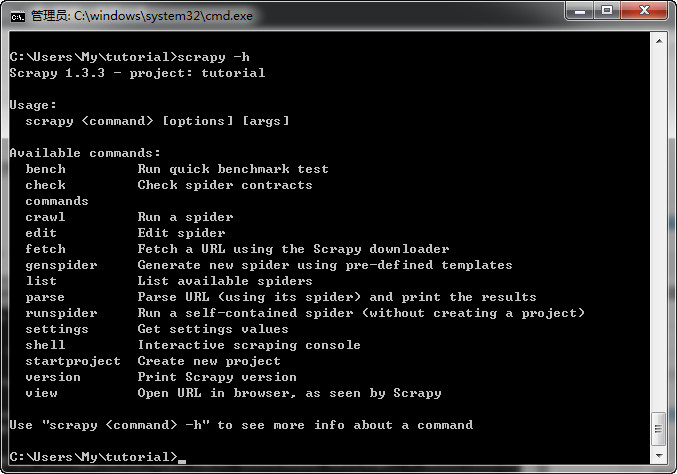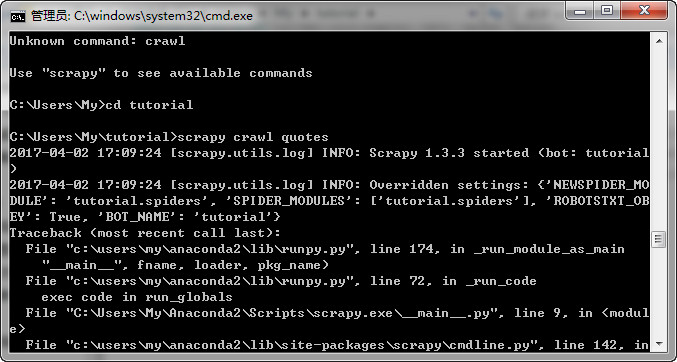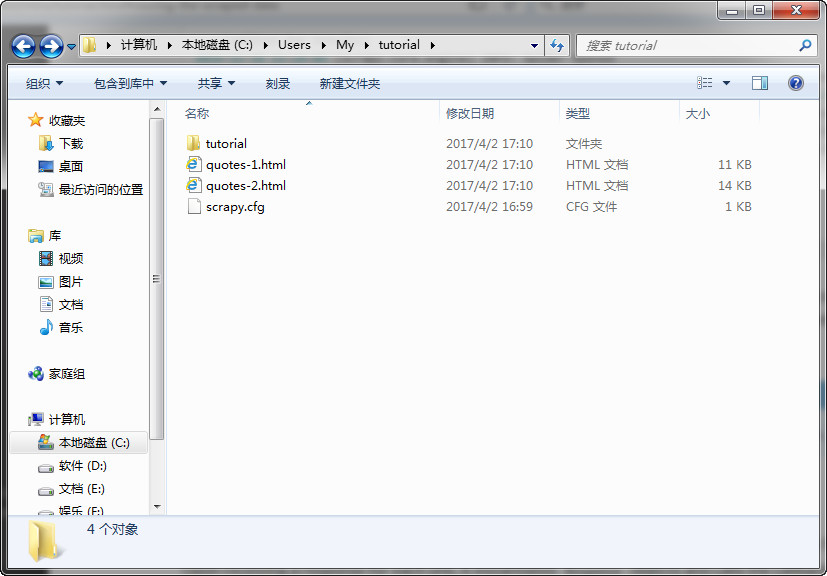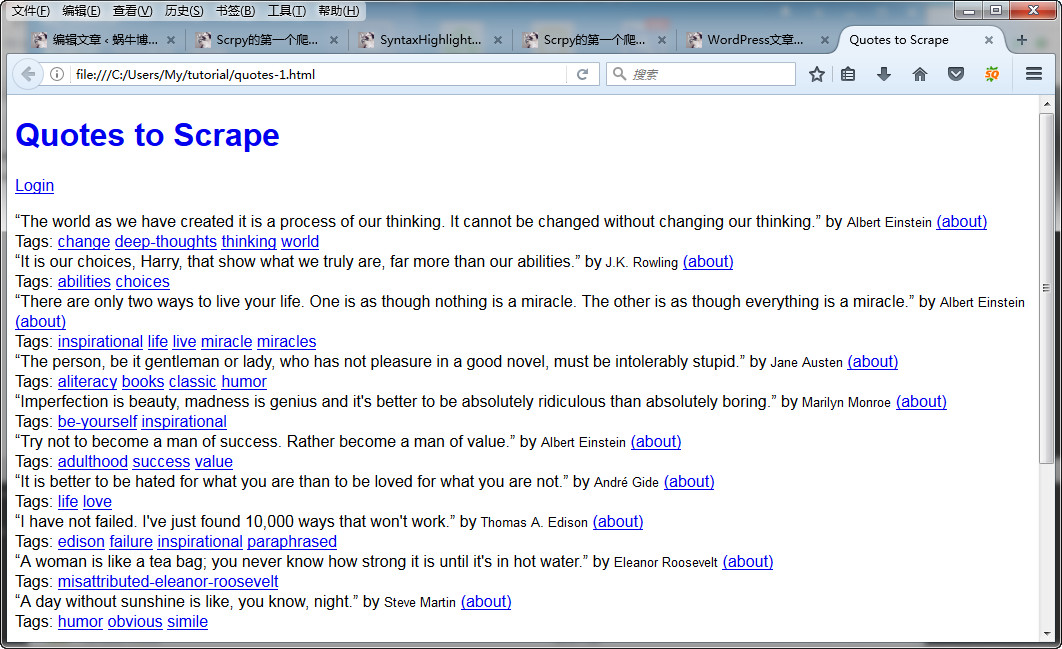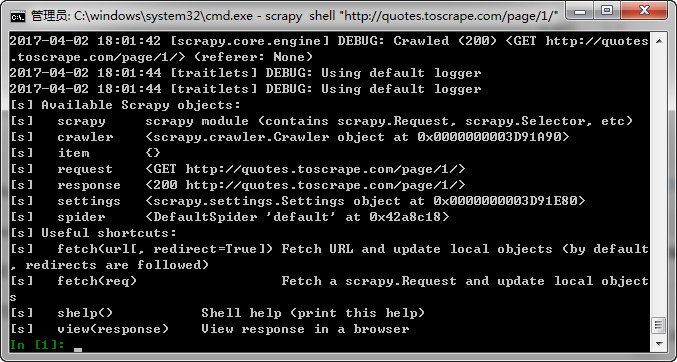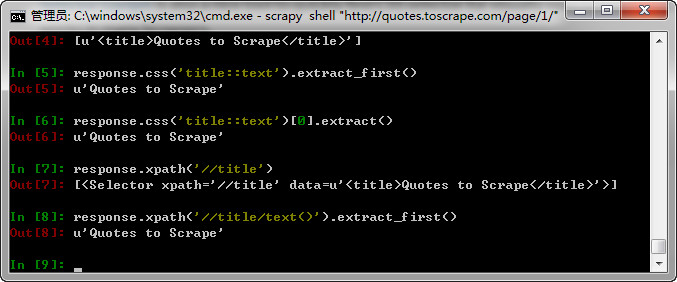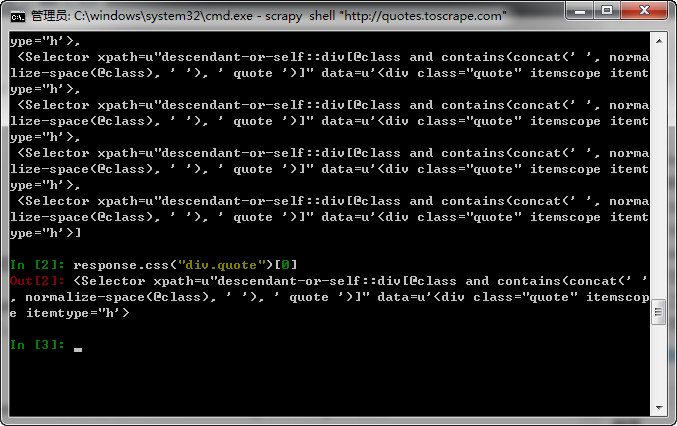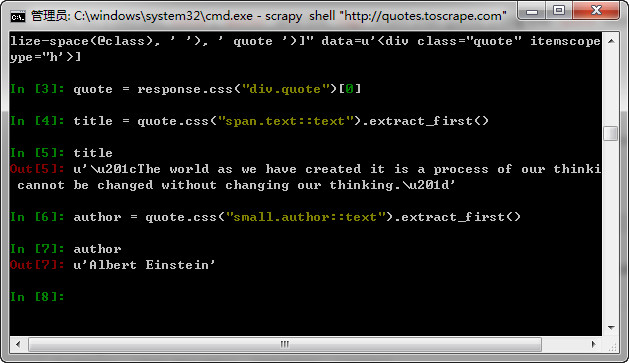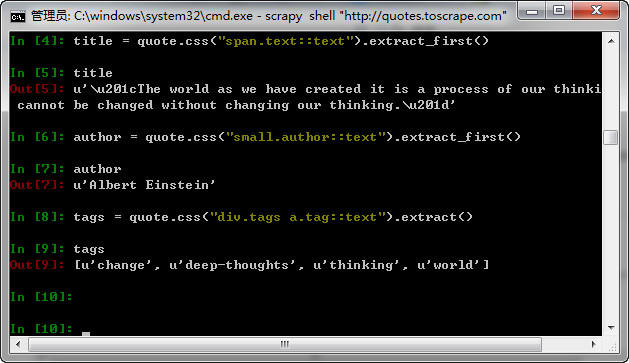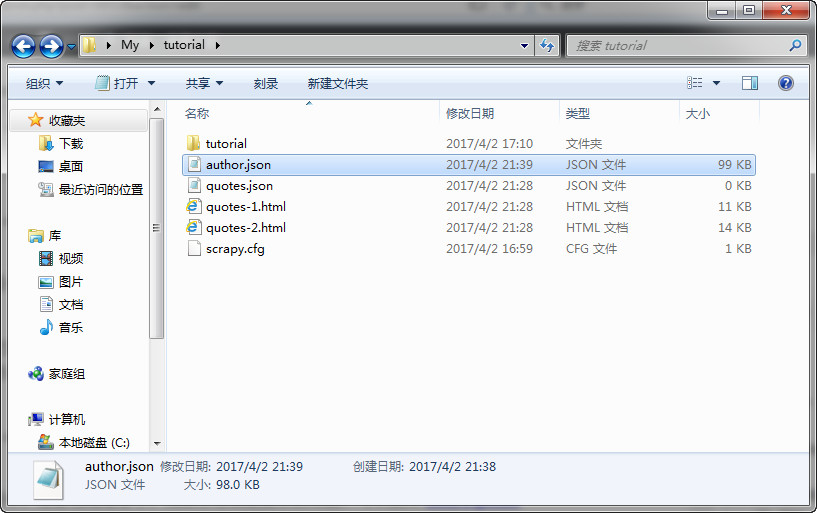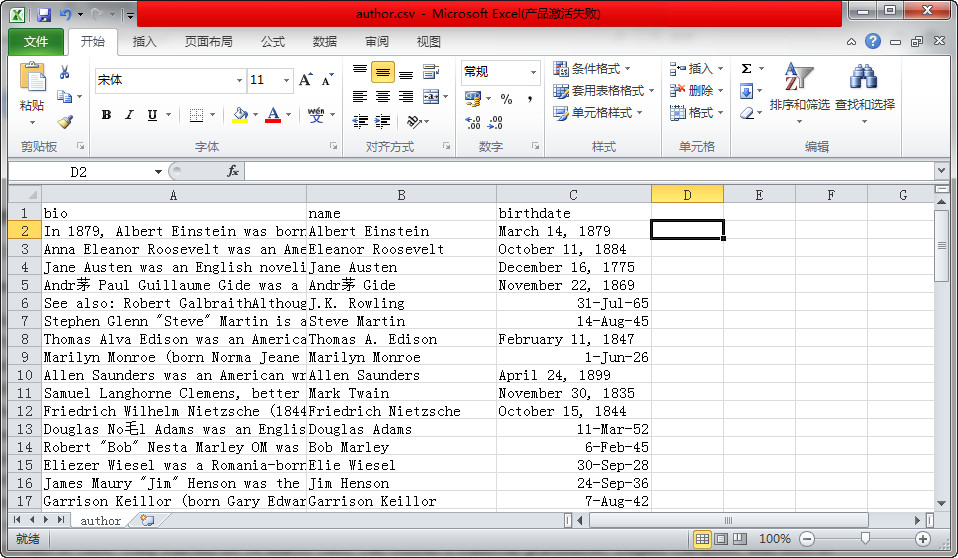学习目标:
- 学会安装Scrapy
- 了解使用Scrapy抓取特定网页内容,并将结果储存为json、csv文件的方法
- 学会使用Scrapy shell
- 学会使用CSS选择器及Xpath
- 学习抓取时访问“下一页”的方法
Windows下Scrpy的安装
如果手动安装的话,比较麻烦,需要先安装lxml和PYwin32,然后再安装Python.
PYwin32下载地址:https://sourceforge.net/projects/pywin32/files/pywin32/Build%20221/
lxml下载地址:https://www.lfd.uci.edu/~gohlke/pythonlibs/#lxml
如果你要在python3.X下安装,可以看这里。
视频地址见:这里。
如果想一键安装的话,可以先安装Anaconda,然后以管理员身份运行CMD,输入下列命令:
conda install scrapy
安装完毕之后,执行“开始--程序--Anaconda”功能,在Anaconda程序的子项下面,运行“Anaconda Prompt”。
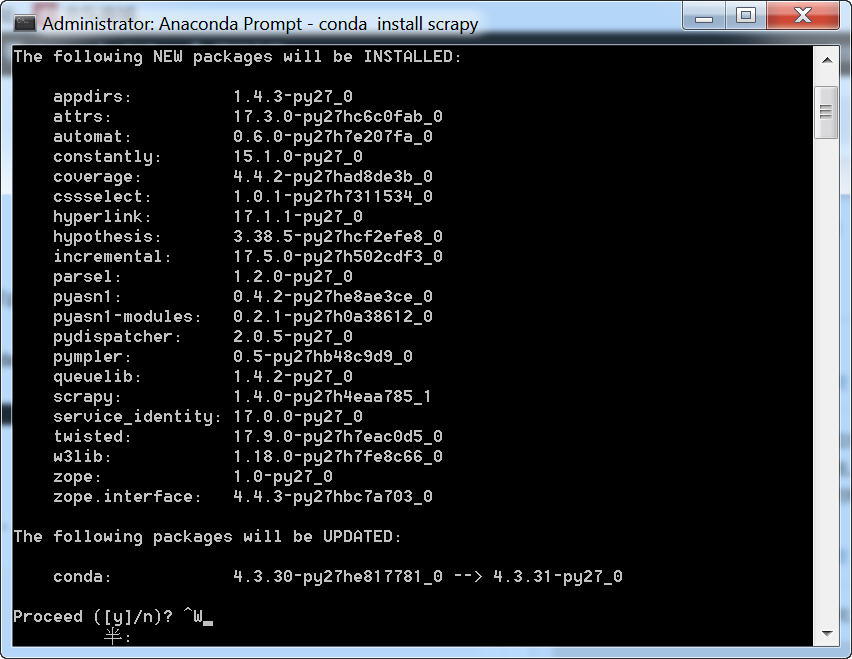
一、新建项目
使用Scrpy采集前,你需要先新建一个项目。进入你想存放Scrpy的目录,然后运行:
scrapy startproject tutorial
运行这个命令后,将会建立一个tutorial的文件夹。
tutorial/
scrapy.cfg # deploy configuration file 项目的配置文件tutorial/ # project's Python module, you'll import your code from here 该项目的python模块
__init__.pyitems.py # project items definition file 定义项目items的文件
pipelines.py # project pipelines file 定义pipelines的文件
settings.py # project settings file 设置项目的文件
spiders/ # a directory where you'll later put your spiders 放置spider代码的目录.
__init__.py
二、建第一个蜘蛛
蜘蛛必须继承scrapy.Spider这个类,它还可以定义如何访问网页上的链接,以及如何剖析网页的内容。
用Pycharm建立一个quotes_spider.py的文件,并将它保存到你之前新建项目的 tutorial/spiders 文件夹下面(这个注意不要放错位置,否则执行不了,上面的示意图就没有选到spider文件夹),quotes_spider.py的代码如下:
import scrapy
class QuotesSpider(scrapy.Spider):
name = "quotes"
def start_requests(self):
urls = [
'http://quotes.toscrape.com/page/1/',
'http://quotes.toscrape.com/page/2/',
]
for url in urls:
yield scrapy.Request(url=url, callback=self.parse)
def parse(self, response):
page = response.url.split("/")[-2]
filename = 'quotes-%s.html' % page
with open(filename, 'wb') as f:
f.write(response.body)
self.log('Saved file %s' % filename)
name: 蜘蛛的名称. 在一个项目中它是唯一的.
start_requests(): 必须是一个可迭代的requests.
parse(): 处理每次返回内容的方法. The response parameter is an instance of TextResponse that holds the page content and has further helpful methods to handle it.
parse()通常剖析返回的内容,将抓取的内容存储为字典,同时寻找新的URLs,继续访问并建立新的请求。
小知识:
运行下面的命令,系统会自动建立一个爬虫文件。
scrapy genspider itcast "http://www.itcast.cn"
三、运行蜘蛛
进入项目中,可以使用scrapy命令来管理和控制您的项目。
可以通过“scrapy <command> -h”命令查看该命令的用法,也可以直接用scrapy -h查看所有的命令。
进入项目的根目录,并执行:scrapy crawl quotes,意思即为运行名称为“quotes”的蜘蛛。
在根目录,我们发现多了:quotes-1.html 和 quotes-2.htm两个文件 。
可以打开看一下效果。
你可能会说,上面这个东西并不是我真正想要的,那么请继续。
四、一种更快捷的处理start_url方法
你可以定义start_url的类别属性,
import scrapy
class QuotesSpider(scrapy.Spider):
name = "quotes"
start_urls = [
'http://quotes.toscrape.com/page/1/',
'http://quotes.toscrape.com/page/2/',
]
def parse(self, response):
page = response.url.split("/")[-2]
filename = 'quotes-%s.html' % page
with open(filename, 'wb') as f:
f.write(response.body)
即使我们没有明确告诉Scrapy如何做,parse()也会自动处理每个URLs的返回数据,因为parse() 是Scrapy默认的callback方法,如果没有指定callback的方法,就自动使用parse()。
五、提取数据
最佳方法是使用Scrapy shell里面的selectors。
如果你是windows系统,执行:
scrapy shell "http://quotes.toscrape.com/page/1/"
注意是双引号,如果是其他系统,则用单引号
使用这个shell,你可以使用CSS选择返回内容中的某一特定值。比如,输入:
response.css('title'),就会返回:
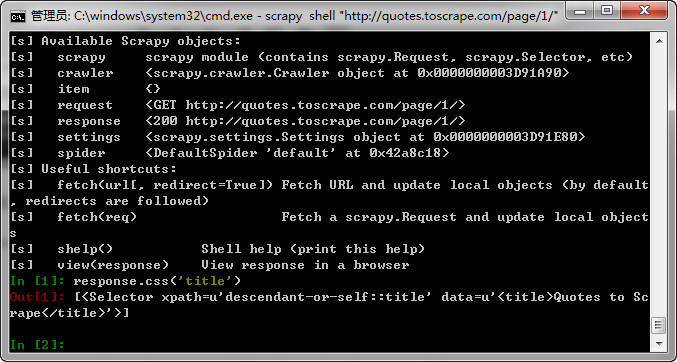
运行response.css('title')返回的结果是一个和列表类似的对象,叫SelectorList,它可以让你进一步提取其中的数据。
比如,我们要提取title的内容。可以使用response.css('title::text').extract()命令:
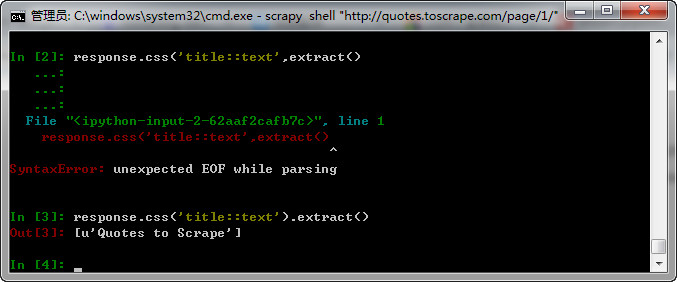
在这里需要注意两点:一是我们加了“::text”,意思即是我们只想提取<title>标签中的文字内容,如果我们不使用
“::text”,那我们将会得到包括<title>标签在内的内容,
response.css('title').extract()
['<title>Quotes to Scrape</title>']
二是执行.extract()的结果是一个列表,如果你想要列表的第一个元素,可以使用“
response.css('title::text').extract_first()”
命令或者使用:
“>>> response.css('title::text')[0].extract()”
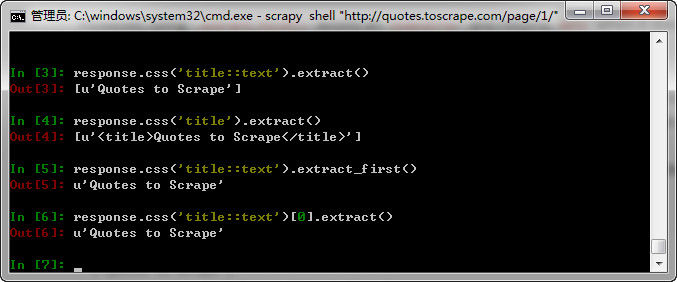
使用.extract_first()命令可以避免IndexError和返回空值(当没有找到任何元素的时候)
这里有个决窍:编写采集代码的时候,有时遇到抓取错误的时候,我们需要忽略它,因它这样即使其中部分出错,我们还能抓取到其他部分的数据。
除了extract() 和 extract_first()的方法,我们还可以用正则表达式的方法取数:
>>> response.css('title::text').re(r'Quotes.*')
['Quotes to Scrape']
>>> response.css('title::text').re(r'Q\w+')
['Quotes']
>>> response.css('title::text').re(r'(\w+) to (\w+)')
['Quotes', 'Scrape']
六、XPath简介
除了CSS,Scrapy支持XPath 表达方法取数。
与CSS相比,XPath更加强大,它可以选择包含“下一页”文本的链接,这在我们采集的时候非常有用,所以,即使你会了CSS提取数据的方法,我还是建议你学习XPath,因为它会让你的数据抓取轻松许多。
退出shell模式的命令是:exit()
另我,我们还可以通过下面的命令统计采集到的数量:
len(response.xpath(".//div[@class='f-list-item']/d1/dd[1]/a/text()").extract()
下面给出给出XPath表达式的例子及对应的含义:
想要学习XPath的使用,请参考:
using XPath with Scrapy Selectors here
this tutorial to learn XPath through examples
this tutorial to learn “how to think in XPath
七、提取内容和作者
每一个内容大概是这样的:
<div class="quote">
<span class="text">“The world as we have created it is a process of our
thinking. It cannot be changed without changing our thinking.”</span>
<span>
by <small class="author">Albert Einstein</small>
<a href="/author/Albert-Einstein">(about)</a>
</span>
<div class="tags">
Tags:
<a class="tag" href="/tag/change/page/1/">change</a>
<a class="tag" href="/tag/deep-thoughts/page/1/">deep-thoughts</a>
<a class="tag" href="/tag/thinking/page/1/">thinking</a>
<a class="tag" href="/tag/world/page/1/">world</a>
</div>
</div>
Windows系统通过CMD窗口“scrapy shell "http://quotes.toscrape.com"”打开shell。
输入“response.css("div.quote")”可以得到一个选择器的列表,通过 “quote = response.css("div.quote")[0]”可以获得第一个元素。
现在提取title, author 和 tags。
Tags是字串的列表,我们可以使用.extract()的方法全部获取。
现在我们抓取所有内容,并将它存到python的字典中。
>>> for quote in response.css("div.quote"):
... text = quote.css("span.text::text").extract_first()
... author = quote.css("small.author::text").extract_first()
... tags = quote.css("div.tags a.tag::text").extract()
... print(dict(text=text, author=author, tags=tags))
{'tags': ['change', 'deep-thoughts', 'thinking', 'world'], 'author': 'Albert Einstein', 'text': '“The world as we have created it is a process of our thinking. It cannot be changed without changing our thinking.”'}
{'tags': ['abilities', 'choices'], 'author': 'J.K. Rowling', 'text': '“It is our choices, Harry, that show what we truly are, far more than our abilities.”'}
... a few more of these, omitted for brevity
>>>
八、提取蜘蛛中的数据
我们使用yield 来提取数据。
import scrapy
class QuotesSpider(scrapy.Spider):
name = "quotes"
start_urls = [
'http://quotes.toscrape.com/page/1/',
'http://quotes.toscrape.com/page/2/',
]
def parse(self, response):
for quote in response.css('div.quote'):
yield {
'text': quote.css('span.text::text').extract_first(),
'author': quote.css('small.author::text').extract_first(),
'tags': quote.css('div.tags a.tag::text').extract(),
}
输出结果是:
2016-09-19 18:57:19 [scrapy.core.scraper] DEBUG: Scraped from <200 http://quotes.toscrape.com/page/1/>
{'tags': ['life', 'love'], 'author': 'André Gide', 'text': '“It is better to be hated for what you are than to be loved for what you are not.”'}
2016-09-19 18:57:19 [scrapy.core.scraper] DEBUG: Scraped from <200 http://quotes.toscrape.com/page/1/>
{'tags': ['edison', 'failure', 'inspirational', 'paraphrased'], 'author': 'Thomas A. Edison', 'text': "“I have not failed. I've just found 10,000 ways that won't work.”"}
九、储存采集到的数据
最简单的方法是使用Feed exports,使用
scrapy crawl quotes -o quotes.json
将会生成一个quotes.json文件。
格式是这样的:
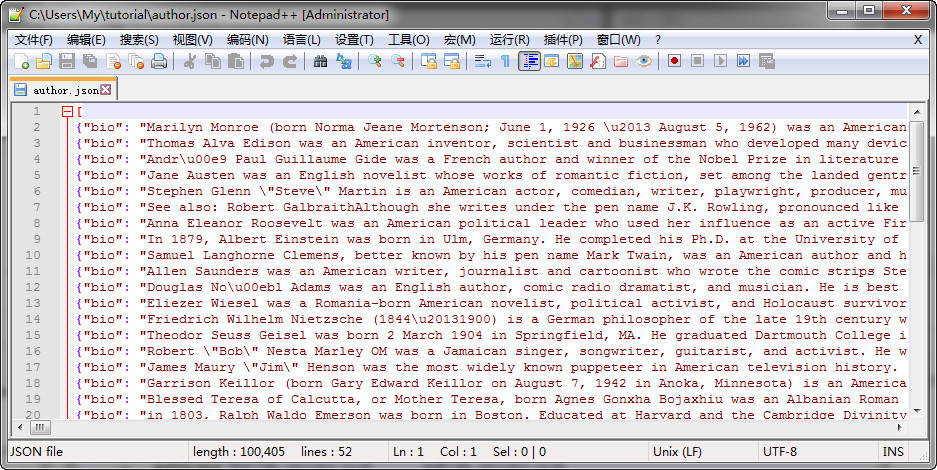
由于历史原因,如果你执行这个命令两次,就会覆盖原来的json文件,从而破坏了json 文件。
为了避免以上问题,你可以使用JSON Lines,命令是
scrapy crawl quotes -o quotes.jl
同理,如果执行:
scrapy crawl quotes -o quotes.csv
备注:
如果打开csv文件,中文显示乱码,可以用notepad转码,再保存成为csv就不会乱码了。
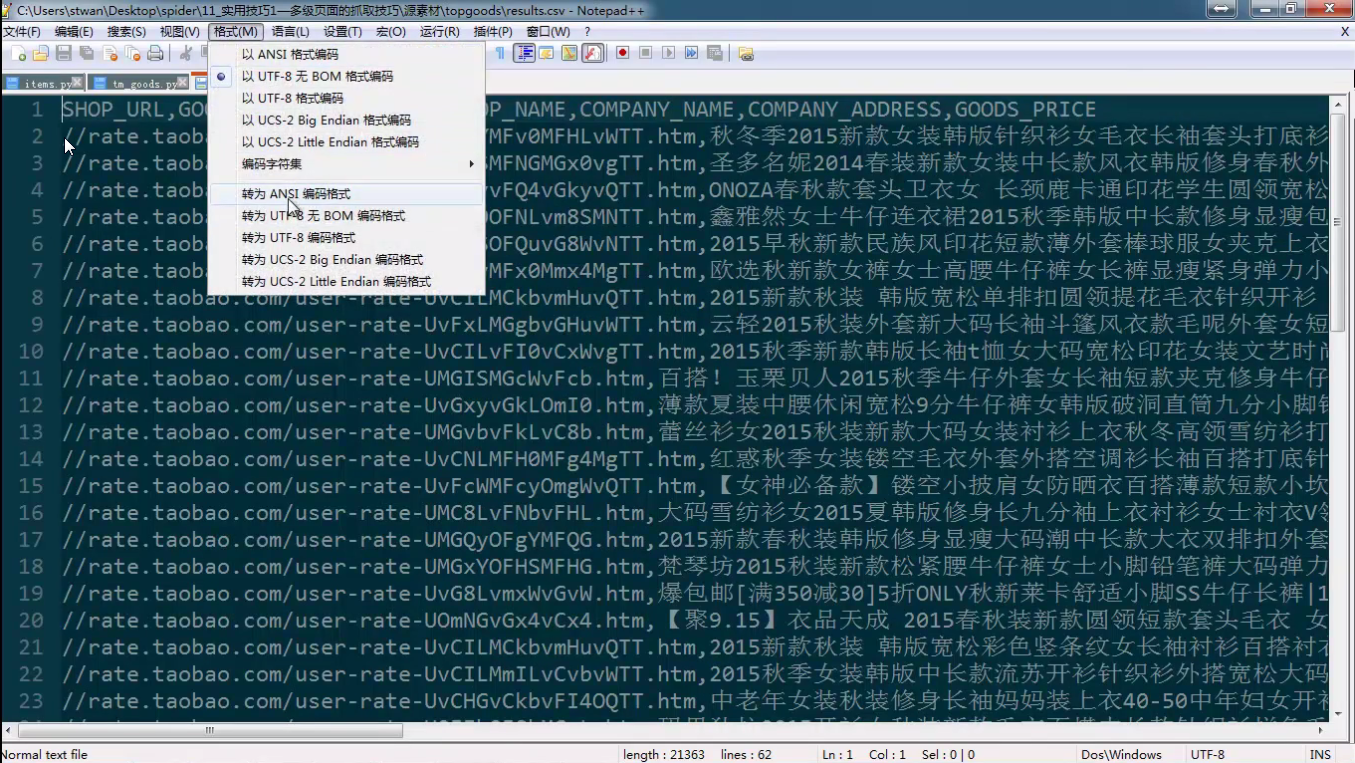
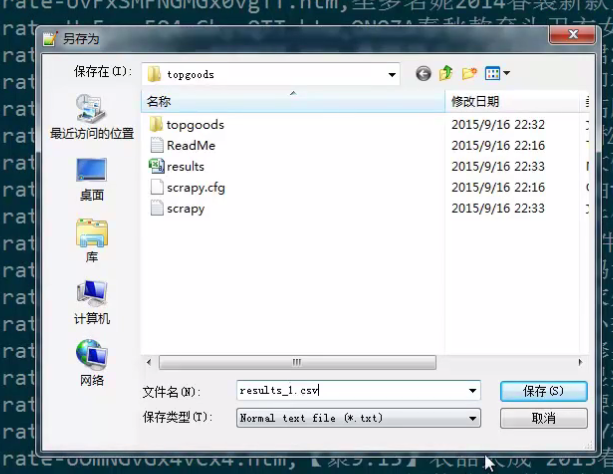
在小项目中,这些已经足够了,如果你想做更复杂的项目,可以使用 Item Pipeline
十、访问链接
如果我们不是抓取两个网页,而是一个网站的所有网页,下面我们看看如何访问网页上的链接。
首先我们需要提取网页中的链接,查看网页源代码,我们可以看到,一个链接到“下一页”的链接是这样的:
<ul class="pager">
<li class="next">
<a href="/page/2/">Next <span aria-hidden="true">→</span></a>
</li>
</ul>
我们可以在shell中提取数据
>>> response.css('li.next a').extract_first()
'<a href="/page/2/">Next <span aria-hidden="true">→</span></a>'
如果我们想要href的值,可以用:
>>> response.css('li.next a::attr(href)').extract_first()
'/page/2/'
再在看spider代码:
import scrapy
class QuotesSpider(scrapy.Spider):
name = "quotes"
start_urls = [
'http://quotes.toscrape.com/page/1/',
]
def parse(self, response):
for quote in response.css('div.quote'):
yield {
'text': quote.css('span.text::text').extract_first(),
'author': quote.css('small.author::text').extract_first(),
'tags': quote.css('div.tags a.tag::text').extract(),
}
next_page = response.css('li.next a::attr(href)').extract_first()
if next_page is not None:
next_page = response.urljoin(next_page)
yield scrapy.Request(next_page, callback=self.parse)
提取数据之后,parse() 查找到“下一页”的链接,使用urljoin()生成绝对路径,再生成一个新的请求抓取下一页。
原文及更多的例子请参考:
https://doc.scrapy.org/en/latest/intro/tutorial.html#storing-the-scraped-data
十一、scrapy实现登陆
